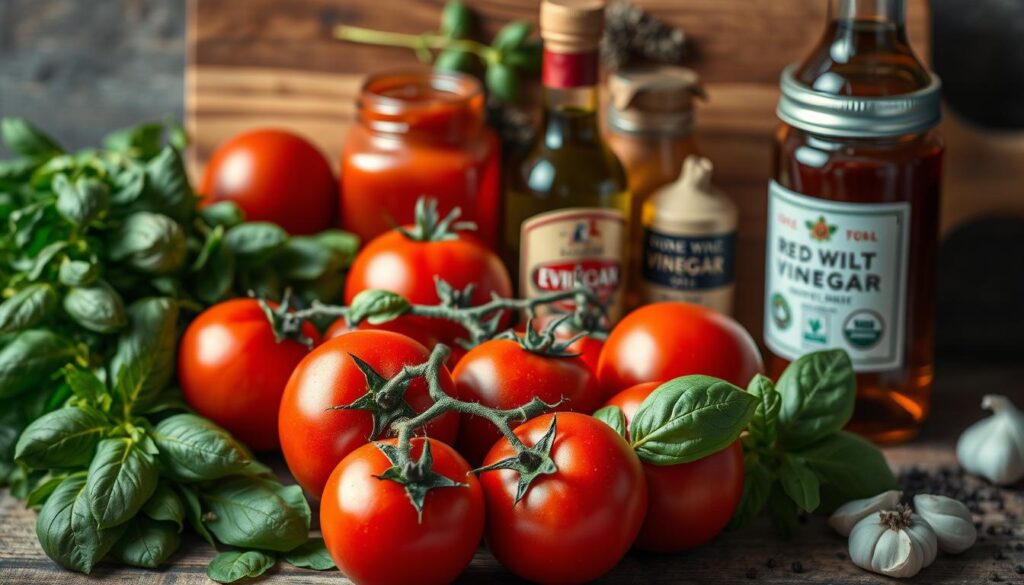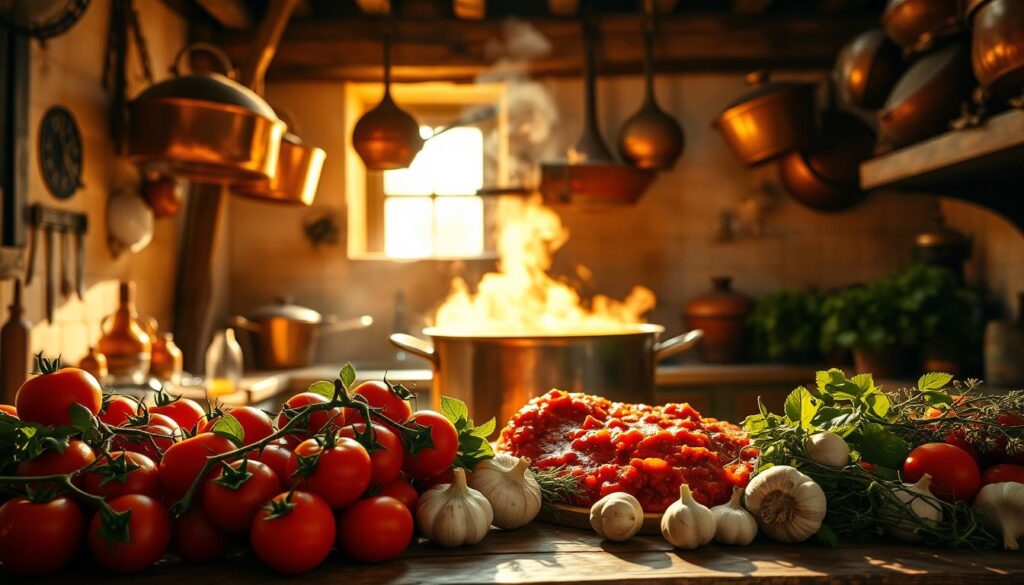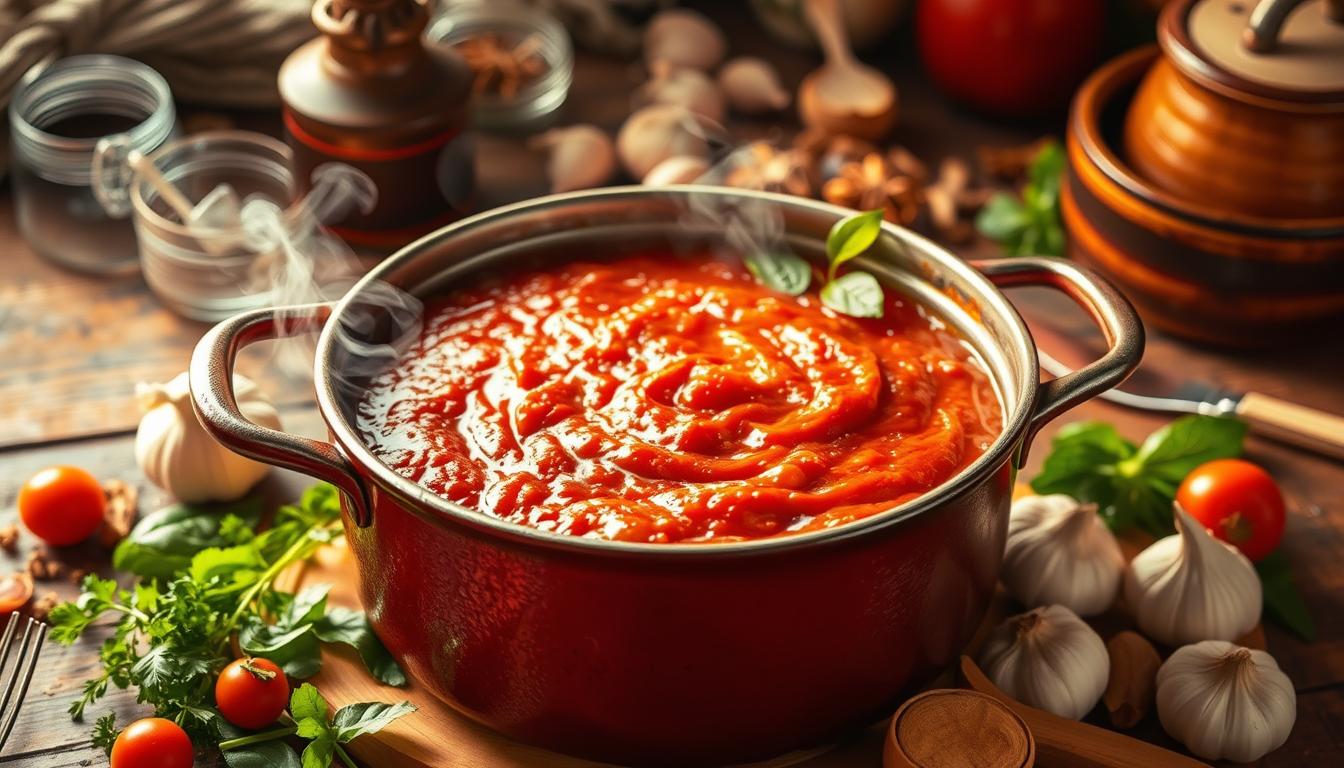The smell of spaghetti sauce reminds me of my grandmother’s kitchen. I remember watching her cook for hours, creating a rich sauce. Making homemade spaghetti sauce is more than a recipe; it’s a journey of flavors.
Making the best spaghetti sauce is a tradition passed down through generations. It’s about finding the right mix of ingredients and simmering them slowly. Whether you’re new to cooking or experienced, making authentic spaghetti sauce can improve your skills and bring Italy to your table.
Key Takeaways
- Authentic spaghetti sauce requires slow cooking for 3-6 hours
- Fresh ingredients are crucial for exceptional flavor
- San Marzano tomatoes offer the most authentic taste
- Garlic and fresh basil are fundamental to traditional recipes
- Homemade sauce allows complete control over ingredients
Understanding Spaghetti Sauce Basics
Making the perfect classic spaghetti sauce is an art. It turns simple ingredients into a masterpiece. Whether you cook at home or love pasta, knowing the basics can improve your skills and wow your guests.

What Is Spaghetti Sauce?
Spaghetti sauce is more than just a pasta topping. It’s a mix of ingredients that add flavor and character to pasta dishes. Traditional Italian sauces are tomato-based, with herbs, spices, and aromatics.
Key Ingredients for Perfect Sauce
To make a real classic spaghetti sauce, you need a few key things:
- Tomatoes: The base of any great sauce
- Fresh herbs like basil and oregano
- Garlic and onions for flavor
- Quality olive oil
- Optional protein like ground beef or pancetta
“A great sauce is about balance and letting each ingredient shine”
An easy spaghetti sauce can be made in under 30 minutes. The secret is using fresh, quality ingredients. Most homemade marinara sauces need just five things: tomatoes, garlic, olive oil, salt, and basil.
Marinara sauce has about 130 calories per serving. It has 15 grams of carbs and 3 grams of protein. Tip: Add fresh basil in the last 5 minutes to get the most flavor.
The History of Spaghetti Sauce
Spaghetti sauce has a long history, deeply rooted in Italian cooking. Its journey is filled with cultural changes and new cooking ideas.

- In 1692, the first Italian recipe for tomato sauce appeared in chef Antonio Latini’s cookbook
- Tomatoes arrived in Europe during the 16th century after Spanish colonization of the Americas
- Initial European perceptions considered tomatoes exotic and potentially dangerous
Origins in Italy
Tomatoes changed Italian cooking. The first spaghetti and tomato sauce recipe was in 1844. This was a big moment in cooking history.
Places like Bologna and Naples made their own sauce styles. These sauces showed off local ingredients and cooking ways.
“Cooking is about passion, and Italian sauce tells a story of generations.” – Unknown Italian Chef
Evolution Over Time
When Italian immigrants came to the United States, they brought their favorite spaghetti sauce recipes. Ettore Bioardi (Chef Boyardee) started selling pasta sauces in the 1920s. This made traditional spaghetti sauce known to more people.
The sauce’s story shows how simple ingredients can become a cultural treasure. It connects people through taste and tradition.
Types of Spaghetti Sauce
Exploring the world of spaghetti sauce is a culinary adventure. It can turn your meal into something special. Each sauce offers unique flavors and textures that match your favorite pasta dishes.
The pasta sauce world is full of different options. Each one adds its own special touch to your cooking. Let’s look at some popular sauce types that can make your dishes better:
Classic Marinara vs. Hearty Bolognese
Marinara and Bolognese are two top sauces in the pasta world. Quick spaghetti sauce fans love marinara for its easy making. It takes about 20-30 minutes to prepare. This tomato-based sauce includes:
- Fresh tomatoes
- Garlic
- Olive oil
- Basic herbs
Bolognese, from Bologna, is more hearty. This meat-based sauce mixes minced vegetables and protein. It has a rich, complex flavor that takes hours to simmer.
Creamy Alfredo and Beyond
For a luxurious taste, try creamy Alfredo sauce. It was first made in 1914 by Alfredo Di Lelio in Rome. What started as simple butter and cheese is now a creamy delight that perfectly coats pasta.
“A great sauce can turn a simple pasta dish into a memorable meal” – Italian Culinary Tradition
Whether you like a light marinara or a hearty Bolognese, knowing these sauces can help you make amazing pasta dishes at home.
Essential Cooking Techniques
To make the best spaghetti sauce, you need to learn a few key techniques. These methods will turn simple ingredients into a tasty homemade sauce. They will also improve your cooking skills and help you make a true Italian-style sauce.
Sautéing Aromatics: The Flavor Foundation
The secret to a rich best spaghetti sauce recipe is in sautéing aromatics right. Chop your ingredients finely for even cooking and to release more flavor. Here’s a quick guide:
- Use olive oil heated to medium-low
- Add onions first, cooking until translucent
- Introduce garlic last to prevent burning
- Stir frequently for even browning
Simmering: Developing Deep Flavors
Simmering is where the magic happens in your homemade spaghetti sauce. Cooking it low and slow lets the ingredients blend, creating deep flavors. Aim to simmer your sauce for at least 15-30 minutes, stirring occasionally.
*The longer you simmer, the more developed your sauce becomes*
Pro tip: Use a wide, shallow pan to maximize surface area and encourage faster flavor development. Keep the heat low to prevent burning and maintain a gentle bubble.
Choosing the Right Tomatoes
Creating an authentic spaghetti sauce starts with picking the perfect tomatoes. The right tomato can make your sauce go from good to great. It adds depth and richness to every bite.
Fresh vs. Canned: A Tomato Showdown
When making your spaghetti sauce, you must choose: fresh or canned tomatoes? Both have their own benefits for a tasty sauce.
- Fresh tomatoes give vibrant flavor and a garden-fresh taste
- Canned tomatoes offer consistent quality all year
- Peak-season canned tomatoes are at their ripest
Best Tomato Varieties for Sauce
Not all tomatoes are the same for spaghetti sauce. Some stand out more in the kitchen.
- San Marzano: The top choice for authentic spaghetti sauce
- Low acidity
- Sweet flavor
- Dense, meaty texture
- Roma Tomatoes: Quick-growing and great for sauce
- Produces fruit in about 70 days
- Less watery than other varieties
“The secret to an incredible spaghetti sauce is choosing tomatoes that are rich, flavorful, and perfectly suited to cooking.”
Pro tip: For the best flavor, mix canned San Marzano tomatoes with fresh heirloom paste tomatoes. This mix balances richness and brightness, making your sauce top-notch.
Flavor Enhancers
Making a tasty spaghetti sauce is more than just basic ingredients. The right flavor enhancers can turn a simple sauce into a dish that wows your guests.
Herbs That Make Your Sauce Sing
Fresh herbs are key to a great spaghetti sauce. Here are some top choices:
- Fresh basil for a bright, aromatic touch
- Oregano to add an earthy Mediterranean flavor
- Parsley for a fresh, clean taste
- Thyme for subtle depth
Protein Power: Adding Depth to Your Sauce
Proteins can make your sauce much more complex. A little MSG can boost the umami flavor. Some great protein additions are:
- Ground beef and pork for rich texture
- Anchovies for deep, salty undertones
- Mushrooms for an earthy dimension
Pro tip: A splash of red wine (½ to 3 cups) can add incredible depth to your delicious spaghetti sauce.
Unexpected Flavor Boosters
Don’t be shy to try new ingredients. Consider adding:
- A pinch of baking soda (¼ teaspoon per cup) to reduce acidity
- Worcestershire sauce (1 tablespoon) for complex flavor
- Ricotta cheese for creamy richness
Creating a classic spaghetti sauce is an art. Each ingredient has its own story. Your personal touch makes the sauce uniquely yours.
Cooking Time and Its Importance
Knowing how long to cook your spaghetti sauce can make a big difference. The time you spend simmering it affects its taste and quality.
When making an easy spaghetti sauce, cooking time is key. It helps create rich, complex flavors. Some sauces are quick to make, while others need slow simmering.
Quick Sauces vs. Long-Simmered Techniques
Different cooking methods give different results:
- Quick spaghetti sauce (15-30 minutes): Great for busy weeknights
- Medium-length sauce (1-2 hours): Balanced flavors
- Long-simmered sauce (2-8 hours): Deepest flavors
Flavor Development through Time
“Great sauce is about patience and understanding how ingredients meld together.”
The longer you simmer your sauce, the richer the flavors get. Umami-rich ingredients like tomatoes, mushrooms, and meat get deeper flavors over time.
Pro tip: If you’re short on time, use techniques like sautéing aromatics. Choose high-quality ingredients to boost flavor in your quick spaghetti sauce.
Common Mistakes to Avoid
Making the best spaghetti sauce is more than just mixing ingredients. Many home cooks make mistakes that ruin a good homemade sauce. These errors can turn a tasty meal into a letdown.
To make a perfect sauce, you need to pay close attention and know what to avoid. Here are the most common mistakes that can mess up your sauce:
Avoiding Over-Spicing Your Sauce
Seasoning is an art when making the best spaghetti sauce. Here are some tips:
- Start with small amounts of herbs and spices
- Taste frequently during cooking
- Remember that flavors get stronger as it simmers
- Use fresh herbs for a better taste
“Seasoning is about balance, not overwhelming the sauce” – Professional Chef
Protecting Your Sauce’s Texture
Texture is key to a great homemade spaghetti sauce. Half of the cooks agree that the right seasoning and texture are essential.
- Avoid over-stirring, which can break down ingredients
- Simmer sauce slowly to develop rich consistency
- Use high-quality tomatoes for smoother texture
- Allow sauce to rest before serving
Pro tip: Patience during cooking can improve your sauce’s thickness by up to 50%.
By knowing these common mistakes, you’ll be closer to making a spaghetti sauce that will wow your family and friends.
Pairing Spaghetti Sauce with Pasta
Finding the perfect pasta for your spaghetti sauce can make your meal amazing. Italy has over 350 pasta shapes. It’s important to pick the right one for your sauce.
Choosing the right pasta for spaghetti sauce is key. Different pasta shapes work better with different sauce types. This creates unique dining experiences.
Best Types of Pasta
Here are some tips for pairing pasta with spaghetti sauce:
- Long dry pasta (spaghetti, bucatini, linguine) is great with tomato and seafood sauces
- Short pasta shapes like orecchiette are perfect for hearty sauces with vegetables
- Curly pasta (fusilli, trofie) holds chunky sauces well
- Tubular pasta is great with big, chunky sauces
Cooking Pasta to Perfection
“In Italy, pasta is an art form, not just a meal.”
Getting your pasta just right is crucial. Use plenty of salt in the water and cook until al dente. This means it’s tender but still has a bit of firmness.
Traditionally, Italians toss pasta with sauce right away. This helps the pasta soak up all the flavors.
Pro tip: Save some pasta water. It makes the sauce smooth and helps it stick to your pasta.
Serving Ideas and Presentation
Creating the perfect spaghetti sauce is an art. It’s not just about cooking. The way you present it can make a big difference. You want every plate to look good and taste great.
Plating Your Dish
When serving pasta, use these tips:
- Choose wide, white plates to highlight sauce colors
- Twirl spaghetti into a neat circle with a fork
- Make the pasta stand out by lifting it slightly in the middle
- Make sure sauce covers the dish evenly
Garnishing for Appeal
Enhance your spaghetti sauce with garnishes. Fresh herbs can boost both looks and taste. Here are some ideas:
- Sprinkle fresh basil leaves for a pop of green
- Grate Parmigiano-Reggiano cheese on top
- Drizzle extra virgin olive oil for shine
- Add red pepper flakes for color and spice
“Great pasta is about passion, presentation, and perfection.” – Italian Chef Tradition
Remember, presentation is key. Your authentic spaghetti sauce should be beautifully presented. This turns a simple meal into a special experience.
DIY Spaghetti Sauce Recipes
Making your own spaghetti sauce is simple. You just need a few ingredients and basic cooking skills. This way, you can make a sauce that’s as good as what you find in restaurants. Plus, you can make it your own by adding your favorite flavors.
A classic marinara sauce needs just a few things: olive oil, garlic, canned tomatoes, and herbs. You can make it in under an hour. Most of that time is spent letting the flavors get richer. You can also add ground beef or Italian sausage for a meatier sauce.
Classic Marinara Recipe
Begin by heating 1/4 cup of olive oil in a big pan. Add chopped onions and minced garlic and cook until they smell great. Then, add two 28-ounce cans of crushed tomatoes, 2 teaspoons of Italian seasoning, and 1 tablespoon of tomato paste.
Let the sauce simmer for 20-30 minutes. This lets the flavors mix well. Season with salt, pepper, and fresh basil for a true Italian taste.
Customized Sauces for Your Taste
Your spaghetti sauce can be a place for creativity. Try adding ground beef or Italian sausage, or veggies like bell peppers and mushrooms. You can also change the herbs and spices to your liking. Add red pepper flakes for spice or a bit of sugar to balance it out.
Remember, the best sauce is the one that makes you happy. So, don’t be afraid to experiment and find your favorite flavors.

